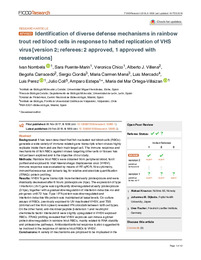Por favor, use este identificador para citar o enlazar este ítem:
https://hdl.handle.net/11000/34447Registro completo de metadatos
| Campo DC | Valor | Lengua/Idioma |
|---|---|---|
| dc.contributor.author | Nombela, Ivan | - |
| dc.contributor.author | Puente Marin, Sara | - |
| dc.contributor.author | CHICO GRAS, VERONICA | - |
| dc.contributor.author | Villena, Alberto J. | - |
| dc.contributor.author | Carracedo, Begoña | - |
| dc.contributor.author | Ciordia, Sergio | - |
| dc.contributor.author | Mena, Maria Carmen | - |
| dc.contributor.author | Mercado, Luis | - |
| dc.contributor.author | Perez, Luis | - |
| dc.contributor.author | coll, julio | - |
| dc.contributor.author | ESTEPA, AMPARO | - |
| dc.contributor.author | Ortega-Villaizan, Maria del Mar | - |
| dc.date.accessioned | 2025-01-14T12:54:07Z | - |
| dc.date.available | 2025-01-14T12:54:07Z | - |
| dc.date.created | 2018-02 | - |
| dc.identifier.citation | F1000Research, 2017 | es_ES |
| dc.identifier.issn | 2046-1402 | - |
| dc.identifier.uri | https://hdl.handle.net/11000/34447 | - |
| dc.description.abstract | Background: It has been described that fish nucleated red blood cells (RBCs) generate a wide variety of immune-related gene transcripts when viruses highly replicate inside them and are their main target cell. The immune response and mechanisms of fish RBCs against viruses targeting other cells or tissues has not yet been explored and is the objective of our study. Methods: Rainbow trout RBCs were obtained from peripheral blood, ficoll purified and exposed to Viral Haemorrhagic Septicaemia virus (VHSV). Immune response was evaluated by means of RT-qPCR, flow cytometry, immunofluorescence and isobaric tag for relative and absolute quantification (iTRAQ) protein profiling. Results: VHSV N gene transcripts incremented early postexposure and were drastically decreased after 6 hours postexposure (hpe). The expression of type I interferon ( ifn1) gene was significantly downregulated at early postexposure (3 hpe), together with a gradual downregulation of interferon-inducible mx and pkr genes until 72 hpe. Type I IFN protein was downregulated and interferon-inducible Mx protein was maintained at basal levels. Co-culture assays of RBCs, previously exposed to UV-inactivated VHSV, and TSS (stromal cell line from spleen) revealed IFN crosstalk between both cell types. On the other hand, anti-microbial peptide β-defensin 1 and neutrophil chemotactic factor interleukin 8 were slightly upregulated in VHSV-exposed RBCs. iTRAQ profiling revealed that VHSV exposure can induce a global protein downregulation in rainbow trout RBCs, mainly related to RNA stability and proteasome pathways. Antioxidant/antiviral response is also suggested to be involved in the response of rainbow trout RBCs to VHSV. Conclusions: A variety of mechanisms are proposed to be implicated in the antiviral response of rainbow trout RBCs against VHSV halted infection. Ongoing research is focused on understanding the mechanisms in detail. | es_ES |
| dc.format | application/pdf | es_ES |
| dc.format.extent | 42 | es_ES |
| dc.language.iso | eng | es_ES |
| dc.publisher | Taylor and Francis | es_ES |
| dc.rights | info:eu-repo/semantics/openAccess | es_ES |
| dc.rights.uri | http://creativecommons.org/licenses/by-nc-nd/4.0/ | * |
| dc.subject | VHSV | es_ES |
| dc.subject | antiviral | es_ES |
| dc.subject | immune response | es_ES |
| dc.subject | nucleated red blood cells | es_ES |
| dc.subject | rainbow trout | es_ES |
| dc.subject | rhabdovirus | es_ES |
| dc.subject.other | CDU::6 - Ciencias aplicadas::60 - Cuestiones generales de las ciencias aplicadas | es_ES |
| dc.title | Identification of diverse defense mechanisms in rainbow trout red blood cells in response to halted replication of VHS virus | es_ES |
| dc.type | info:eu-repo/semantics/article | es_ES |
| dc.contributor.institute | Institutos de la UMH::Instituto de Investigación, Desarrollo e Innovación en Biotecnología Sanitaria de Elche | es_ES |
| dc.relation.publisherversion | https://doi.org/10.12688/f1000research.12985.2 | es_ES |

Ver/Abrir:
f1000research-6-15111.pdf
3,01 MB
Adobe PDF
Compartir:
 La licencia se describe como: Atribución-NonComercial-NoDerivada 4.0 Internacional.
La licencia se describe como: Atribución-NonComercial-NoDerivada 4.0 Internacional.
.png)